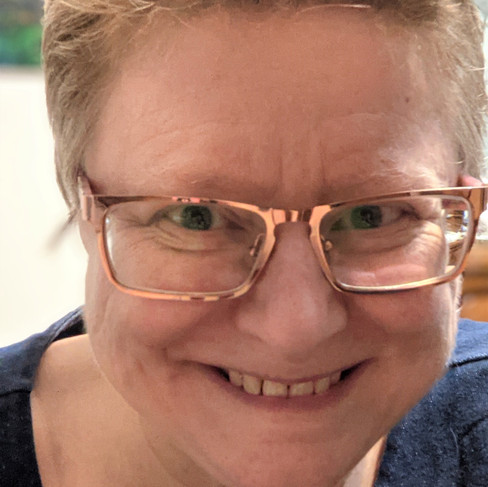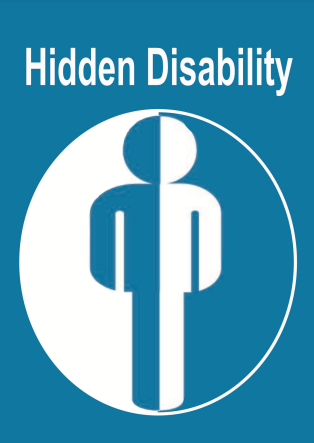A Look At The Hidden Disability Symbol Canada Movement
- Spencer van Vloten
- Aug 7, 2021
- 4 min read

Laura Brydges' hidden disability symbol
By Spencer van Vloten
BC Disability
August 8th, 2021
After a car accident left her with a brain injury, Laura Brydges became increasingly frustrated with the lack of understanding about disabilities that couldn't be seen or heard.
In response, she started a national movement to promote a hidden disability symbol and advocate for policies which remove barriers faced by persons with hidden disabilities. Her movement is growing, and here's what she's calling for.
See More
Laura Brydges: State of Exclusion
FRUSTRATION
At the age of 44, Laura Brydges was in major car accident that would change her life.
Although she survived the collision, she didn't come out unscathed. Laura suffered a brain injury that impaired her ability to take in and retain information: she started having vision problems, sensory processing challenges, and difficulty with memory; she also found herself bogged down by depression.
These changes profoundly impacted her daily living. She felt insecure out in public: things were too intense, too noisy, too complex. Her brain would shut down and she'd find herself overwhelmed, unable to communicate or perform basic tasks.
But with all her disabilities hidden to the plain eye, no one around Laura in these moments knew what was going on or why she was struggling. There were stares, laughs, and other unappreciated reactions.
Growing frustrated with the lack of understanding, she decided she had to do something to bring attention to the issue.
SECOND TIME'S THE CHARM
After thinking it through, Laura chose her course of action.
She'd design a symbol to raise awareness and understanding about hidden disabilities, and to provide a tool that could speak for persons with hidden disabilities when they couldn't.
It didn't all go to plan, however, as her first attempt at creating the symbol ran into problems.
"The first symbol had a chequered design that people found too busy and visually distracting, so I decided it wouldn't work. It was important for me to have something that the community would embrace."
It was her second attempt that would prove to be the keeper. This symbol consisted of a body, divided in half; one of those halves blue, the other white.
The blue side represents what people see, the white side represents what they don’t see, and the circle encompassing the body acknowledges that these two halves come together to form a whole person.
Laura and her hidden disability design
The new symbol quickly caught on. Laura made it available for free download from her website, and it spread throughout Canada, with thousands joining Laura's movement to promote the symbol and to advocate for persons with hidden disabilities.
As support grew, Laura also started a petition that was presented to House of Commons, and Brain Injury Canada and the Brain Injury Society of Toronto joined as partners to help boost the movement.
DISTRUST, EVEN DEATH
The movement addresses the different types of challenges faced by people with hidden disabilities.
In Laura's view, at an institutional level most policies relating to disability don’t include hidden disability. Funding, accessibility measures, and information provision is focused on ramps, mobility devices, and initiatives dealing with physical spaces and persons with visible disabilities.
At an everyday, personal level, Laura's faced plenty of difficulty from people who don't recognize her hidden disabilities, much of which she believes comes from a lack of trust.
"Because people can’t see it or hear it, they don’t believe it exists."
"As a person with a hidden disability, you experience a lot more suspicion, even when dealing with professionals who are supposed to be educated about this type of stuff."
"As a person with a hidden disability, you experience a lot more suspicion"
It gets much worse than skeptical doctors though. As she notes in her paper State of Exclusion, this suspicion and misunderstanding can lead to unemployment, homelessness, and even death, as in the case of a North Carolina man who was shot to death by police as he tried to communicate using sign language.
Better training and education is required in her view to prevent incidents like this, but that's not all that's needed.
CALLS FOR ACTION
For Laura, one of the most powerful steps that could be taken is matching the hidden disability symbol with a world famous partner.
"I want it to always be put next to the universal symbol of accessibility – the ‘wheelchair symbol."
"That symbol focuses on physical spaces and mobility limitations and has been wonderful, but it has its shortcomings, and including the hidden disability symbol with it would help broaden people’s thinking about disability."

Pairing the hidden disability symbol with the international symbol of access (above) would help broaden people's views about disability, says Laura
Along with coupling those two disability symbols, Laura sees collaboration, and a reframing of what it means to have a hidden disability, as essential to creating a stronger hidden disability advocacy movement.
"There needs to be a shift where people stop thinking of hidden disabilities as a bunch of different conditions, like fibromyalgia, brain injury, Ehler-Danlos syndrome, epilepsy or whatever it may be."
"These should be seen under same umbrella of hidden disability diagnosis. They have so many similar needs and features when it comes to cognition, endurance, pain, and mental health, yet these groups are competing against one another when they could do far more together."
JOINING THE MOVEMENT
It should be clear by now that Laura is big on having people come together and work collaboratively for change.
True to this collective spirit, she's calling on everyone to join in and become part of the hidden disability movement.
"What I really want is for people to go to our website and sign our open letter or become an ally. They should also complete the Canadian Survey on Disability by August 31st, and indicate the need for a national hidden disability symbol.
"Another way to show your support is by talking to your MP, your MLA, your city councillor, and just getting the message out there to whoever you can, however you can. It all counts."
Whether you decide to join the movement or not, Laura Brydges will be there as an untiring advocate for an overlooked and misunderstood set of disabilities.

Spencer van Vloten is the editor of BC Disability. To get in touch, send an email to spencer@bcdisability.com!

























Comments